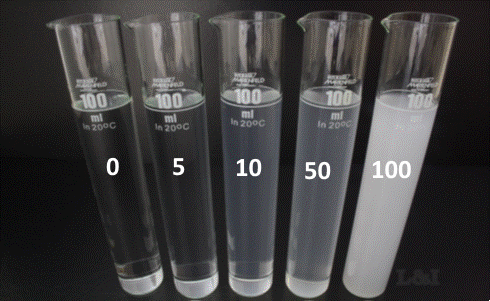
Water miscibility test
The purpose of this test is the qualitative detection of non-water-soluble contaminants. It works on the basis that many previous cargoes are soluble in the wallwash liquid (Methanol, Acetone) but not in water. Sometimes this test is also called Hydrocarbon test. When the wall wash sample is mixed with water, the presence of any cloudiness or turbidity in the sample tube indicates the presence of hydrocarbons or non water-miscible impurities.
EQUIPMENT
- Nessler tubes 100ml.
- Distilled water chloride free
- Pure laboratory Methanol / Acetone
- Penlight.
PROCEDURE
Fill a clean Nessler tube with 25 ml of the wallwash sample. Add 75 ml de-ionised water. Insert stopper, invert once to mix the contents and allow it to stand for 20 minutes. At the same time prepare a reference sample of 25 ml pure laboratory Methanol and 75 ml de-ionised water. Place the tubes on a black surface. Make the room dark and shine light through the side of the tubes by means of a wide beam flashlight, while looking down through the liquid columns.
NOTE: Frequently a penlight is used for this test which makes the evaluation far closer to the Tyndall test. This makes the test far more sensitive due to the intensity of the light beam. Please also note that the reference sample might even show a faint whitish trace when using a penlight
RESULT
Any difference between the reference sample and the wall wash sample means the sample has “failed” for the presence of hydrocarbons. If a bluish tint is present, there are moderate to heavy hydrocarbons. If a whitish haze is observed, this usual indicates slight hydrocarbons.
Factors that might affect the test are
- Cargo tank wet/damp during wall wash sampling.
- Dirty Nessler tubes
- Blue graduation numbers on the tube.
Turbidity after Water Miscibility Test. The digits below refer to Formazin Turbidity Units (FTU). The test result can be analysed with the UV-Spectrometer in Visible Light Mode. The device will deliver the result in FTU.
